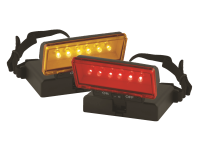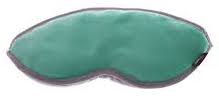If you are a quilter or crafter, you’ll know the importance of having good light to work by. I have two spotlights over my sewing desk, which is fine when I’m working there, but when I get to the stage that involves curling up in bed or on the sofa with the quilting frame, I have a lighting issue. Recently I discovered that some quilters wear head torches for this. You look a bit daft, and anyone you lift your head to talk to won’t appreciate the sudden beam of light in their face, which I can manage. What was bothering me was that the cold white LED shining right above my eyes wasn’t a great option if I wanted to sew in the evenings, in terms of avoiding blue light, and sometimes it would give me a headache.
After some hunting around, I discovered the Beam n Read. It’s a lamp you hang around your neck, so that it points down onto your crafting or your book and not into the face of your startled partner. You can get a version with 3 LEDs or a version with 6 LEDs, with a switch that allows you to turn on just 3 of them if you choose. More relevant to this website, it comes with two snap-on filters that block blue light. One is amber, one is red. The folks at Beam n Read very kindly sent me one for review. It’s the 6 LED model. There’s also a model with a magnifying glass, but I don’t get on with those so I didn’t request it. Here’s their picture showing what they look like with the filters on.
It’s an ingenious little device, especially with the filters. Some people want to be able to see more and can use the amber filter, some want the light to be dimmer and use the red filter, and some simply have a colour preference. They don’t make any medical claims, of course, but it gives you the option to use task lighting that filters out blue light and thus shouldn’t disrupt your melatonin production. Having a personal, focused light can be particularly useful if you are, say, reading in bed and don’t want to disturb your partner, or if you’re getting up to feed a baby and want to minimise everyone’s sleep disruption. The elastic strap which goes around your neck is adjustable, and the lamp itself is sturdily built. If you find that the 6 LED version is a bit bright on its own, you have the option of reducing it to 3 LEDs when it’s on white, and then putting it on 6 LEDs when it has the colour filter on, so that you don’t end up with a light that’s suitably coloured but too dim to see by. The colour filters are great, they give a strong light in two useful and pleasant colours, and you don’t get any light bleeding around the edge. The light seems to be about as strong as my Petzl Tikkina head torch, which is about right for me, neither too dim to work by, nor so bright that you get glare problems. Being bigger (and heavier), it takes bigger batteries, so it’ll last a lot longer before requiring fresh ones.
Unfortunately, it just didn’t work for me. As a child, I remember reading a book which said something along the lines of, “Owen’s parents realised he needed spectacles when they saw him reading with the book six inches away from the end of his nose.” (I have no idea what the book was, but it definitely featured an Owen. I think he was Welsh, and there may have been magic involved.) I thought this was rather odd, as I have always held books that close or closer even with my glasses on! It’s the same when I’m sewing. From what my optometrist says, people who are very short-sighted like me tend to do this, and you end up finding positions for reading and sewing that work nicely for you without much trouble. However, it means that having the light shining from the top of your chest, rather than from somewhere near your eyes, is absolutely useless. I shortened the strap as far as it would go, and moved the quilting frame around, and wriggled. Unless I sat at a really uncomfortable angle which I couldn’t sustain for long, I couldn’t get the light to do more than illuminate the bottom part of the quilting frame. I found the strap rather scratchy as well. Beam n Read mentioned that some quilters make their own strap, which may mean that there are a few other people having this problem, although it could just be a case of quilters wanting to make their own version of any textile in sight.
So then I tried putting it on my forehead. The strap is too long for that, so I grabbed my trusty eye mask and put that on top of it to keep it in place. That worked, but then it felt uncomfortable having that big straight block of plastic against my forehead. A spare fleece wrist warmer worked for padding, and I managed to keep it on my head for long enough to work with. I now had light coming from the angle I wanted, and I could change it to amber light in the evening so that it wouldn’t creep around the edges of my orange-tinted specs! But the set up was quite ridiculous, it’s really not meant to be used that way, and before long it fell off. I don’t have babies who need to be fed in the middle of the night with minimal light, or go camping, or any other uses that I can think of that would work for me. Reluctantly, I gave up on it. I think I’ll have to buy a second head torch and put an orange vinyl filter over it instead.
By this point I was eyeing it wistfully, as it’s a nifty device and I had really wanted it to work. I brought it out to show my friends when they were around for board games, as they are crafters too. The cross stitcher said it wasn’t for her. The spinner is interested, and since they hold their spindle quite low down, it may end up working for them. The knitter wasn’t there and hasn’t been knitting much for a while anyway. My partner, who doesn’t do any of these things (though he does play a variety of musical instruments), is wondering whether he will be able to attach it to a bedpost so that he can read in the evening without having his rather large bedside lamp on and shining white light everywhere. I suspect it won’t really work for that, but we will play around and see what can be done. I’m sure there is someone I know who will find that it’s just the thing for them.
I can’t really give this one a rating, since whether it works for you will depend on whether you like having light coming from your chest rather than near your eyes, and what sort of tasks you will use it for. If you reckon it will suit you, then it’s great. The only thing I’d criticise is the strap, which I hope they improve in the future. Apart from that, it’s the only device of this nature I know of which has orange and red filters, and it’s sturdily built, with a good battery life. You can get head torches with an additional red light built in, but as far as I can tell, the red light on those is too dim for sewing or reading by. I may give one of them a try just to see.

